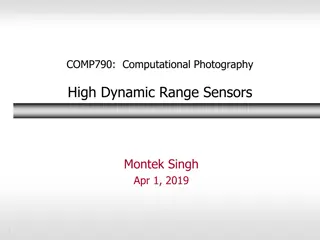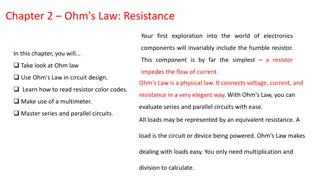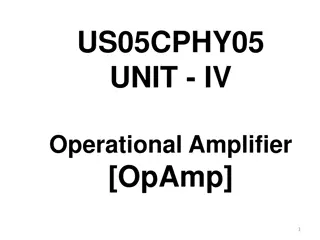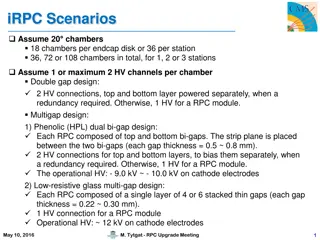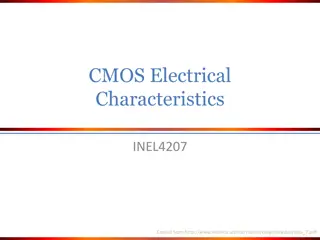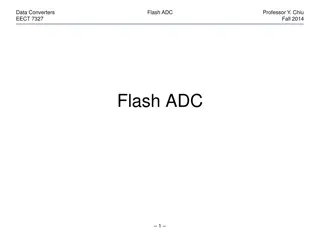Understanding CMOS Comparators and Dynamic Comparators in Electronics
Explore the world of CMOS comparators and dynamic comparators in electronics, including concepts such as offset cancellation, fully-differential comparators, use of op-amps, speed-up techniques, small-signal models, and the need for RS latch in dynamic comparator circuits. Discover how these components function and how they are applied in practical electronic systems.
Download Presentation

Please find below an Image/Link to download the presentation.
The content on the website is provided AS IS for your information and personal use only. It may not be sold, licensed, or shared on other websites without obtaining consent from the author. Download presentation by click this link. If you encounter any issues during the download, it is possible that the publisher has removed the file from their server.
E N D
Presentation Transcript
Offset Chapter 10 Figure 2 Chapter 10 Figure 03 Finite mismatch in the input pair lead to input-referred offset in any differential amplifier or comparator Offset can be cancelled by sampling it on a capacitor
Offset cancellation Illustrated here with ideal switches Chapter 10 Figure 6
Practical offset cancellation MOS switches introduce charge injection Chapter 10 Figure 7
Fully-differential comparator Reduces impact of charge injection, common-mode noise, etc. Chapter 10 Figure 10
Use of opamps as a comparator Chapter 10 Figure 2 Chapter 10 Figure 4 Opamps compensated for closed-loop stability have a slow dominant pole Example 10.2: time constant of the amplifier is = 1/2 1kHz = 0.16ms Opamps are slow when operated open-loop
Speed-up of opamp Compensation may be disconnected during open-loop operation May provide a speedup of 10-100 x Chapter 10 Figure 5
Dynamic Comparators Dynamic comparators use positive feedback to provide regenerative gain with much higher speed They generally have less accuracy, more clock kickback, etc. than opamp-based comparators They can be preceded by a preamplifier to improve their performance Chapter 10 Figure 14 Chapter 10 Figure 15
Dynamic Comparator Operation Chapter 10 Figure 18 Chapter 10 Figure 15
Small-signal model Chapter 10 Figure 16
Need for RS Latch Dynamic comparators generally have a Reset phase to minimize hysteresis Many applications will require them to be followed by a second latch stage that maintains the logic levels during the reset phase Example: dynamic latch on the right When Vltch is low, both Vout+ and Vout- are pulled up high Chapter 10 Figure 19
Example RS Latches S VDD VDD VDD VDD Q Outp Outn A A B B Q R O'Mahony, F. et al, "A 47 10 Gb/s 1.4 mW/Gb/s Parallel Interface in 45 nm CMOS," JSSC Dec. 2010
Typical Dynamic Comparator Architecture Clock Regenerative Positive-Feedback Latch Input Output Amp Pre- RS Latch Reference (sometimes)
Key Specifications Energy consumed per comparison Systematic offset Hysteresis Random offset Input sensitivity Comparator input-referred noise
Energy per comparison IDD Power consumption @ fclk: P = VDDIDD For a dynamic comparator, one expects: P = fclk CeffVDD2 + Pstatic Pstatic may include: Static power consumed in any preamplification stages Leakage Bias circuitry Energy per conversion: Econv = Energy per sec / conv. per second = P / fclk Assuming dynamic power dominates, we expect this to be relatively constant: Econv = CeffVDD2 Worst case will likely be at small input amplitudes (due to longer regeneration period) and toggling outputs (to maximize dynamic activity on all nodes) fclk D Q Vin Vout D Q VDD
Offset & Hysteresis fclk Vin is a slow ramp the comparator is being continuously clocked We expect the output to toggle on the first clock cycle after Vin crosses zero If this doesn t happen, the input voltage required to toggle the output is the offset If the offset so observed is different when the input is increasing and decreasing, then Offset is the average of the two Hysteresis is the difference Hysteresis may be caused by: Incomplete reset of the dynamic latch Memory in the RS latch D Q Vin Vout D Q Vout Hysteresis Observed with Vin increasing Vin Observed with Vin decreasing Voffset
Random Offset fclk D Repeating the experiment over many Monte Carlo runs will yield a Gaussian distribution of offset observations The mean offset observed is systematic offset; e.g. approximately -40mV on the right Caused by asymmetries in the design, including layout parasitics The standard deviation of the observed comparator offsets is caused by random mismatch Q Vin Vout D Q
Sensitivity When the input is very near the comparator s trip point, it may take a long time before regeneration is complete If the time to complete regeneration exceeds the clock period, the comparator is not able to resolve the input Extreme case is when the output never resolves Metastability Metastability Chapter 10 Figure 18
fclk Input-referred noise D Q Vin Vout (small) D Q When the input voltage is precisely set to the comparator trip point, noise will sometimes cause the comparator output to resolve high, sometimes low Repeating the exercise many times can provide statistical data to which may be fit a Gaussian distribution The standard deviation of the Gaussian is the comparator s input-referred rms noise One must be careful to avoid the impact of input offset & hysteresis Chapter 10 Figure 1










